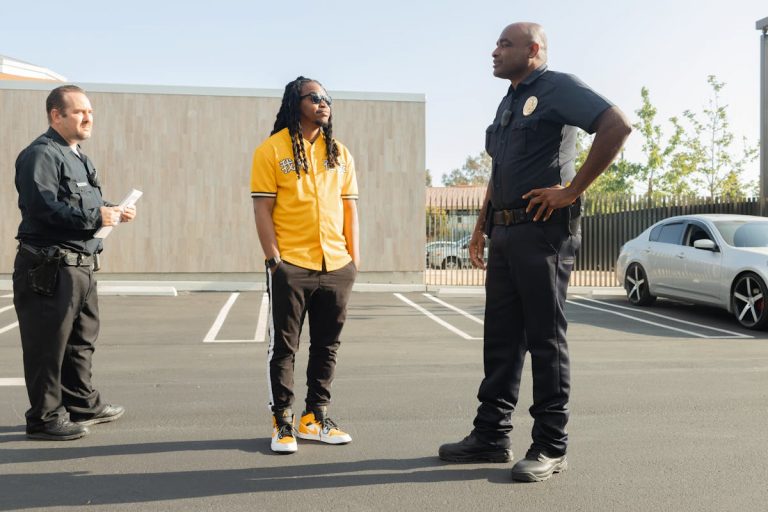As we explore the topic of Arizona’s hit-and-run laws, it becomes apparent that comprehension of these laws is not only essential for motorists traversing Arizona’s roads, but also for legal professionals, law enforcement, and victims of these incidents. The legal implications of not stopping after an accident are severe, with potential criminal charges and civil consequences. Yet, the complexity and nuances of these laws often go unnoticed until one is directly affected. The question then arises – how well do we really understand these laws, their enforcement, and their impact on our daily lives?
Understanding Hit-and-Run Incidents
Regrettably, hit-and-run incidents have become an all-too-common occurrence on Arizona’s roads. The causes of hit and runs vary considerably, but a universal thread involves the driver’s disinclination to take responsibility for their actions. This reluctance typically stems from factors such as fear of legal repercussions, lack of insurance, or impaired driving.
The consequences of these incidents are often severe, leaving victims in need of extensive support. Victims not only have to grapple with physical injuries but also emotional trauma and financial burdens. The abrupt nature of hit-and-run accidents can leave victims feeling helpless, making immediate and long-term support essential for recovery.
A thorough understanding of hit-and-run incidents necessitates a focus on the causes and the importance of victim support. It must also involve a proactive approach towards addressing these concerns. This includes enhancing law enforcement strategies to apprehend offenders, improving driver education, and bolstering victim support mechanisms.
Through these measures, it may be possible to mitigate the frequency of hit-and-run incidents and guarantee that victims are adequately supported during their recovery process. However, it’s also essential to understand the legal definition of hit-and-runs in Arizona, which we will explore in the next section.
The Legal Definition in Arizona
In the context of Arizona law, hit-and-run incidents have a specific legal definition that shapes the consequences for offenders. These penalties under state law aim to discourage such behavior and guarantee justice for victims. Moreover, reporting a hit-and-run incident in Arizona is an essential part of the process, holding a significant place in the legal system.
Understanding Arizona’s Hit-and-Run
Maneuvering through the intricacies of Arizona’s hit-and-run laws can be a challenging task. A hit-and-run, legally defined in Arizona, occurs when a driver involved in a motor vehicle accident fails to stop and provide pertinent information or assistance, when required by law. Regardless of who is at fault, the law mandates all drivers to stop and fulfill certain obligations at the scene.
Understanding the hit-and-run statistics in Arizona can provide valuable insights into the extent of the problem. According to the Arizona Department of Transportation, hit-and-run incidents constitute a significant portion of the total motor vehicle accidents each year. These figures highlight the urgent need to comprehend and comply with the state’s laws to curb this issue.
Victim support is an essential aspect of the legal response to hit-and-run incidents. Arizona law provides mechanisms for victims to receive compensation for their losses. This includes medical costs, property damage, and even emotional distress.
Arizona’s hit-and-run laws are designed to promote responsibility and accountability on the roads. Thus, understanding these laws is not just a legal necessity, but a moral obligation for every driver.
Penalties Under Arizona Law
With respect to Arizona’s hit-and-run laws, penalties meted out are commensurate with the severity of the incident. The state takes these violations seriously, with the law designed to protect victim rights and guarantee justice is served.
Penalties for hit-and-run offenses range from misdemeanor to felony criminal charges. A misdemeanor hit-and-run, where only property damage occurs, may result in up to six months in jail, three years of probation, and a fine of up to $2,500. However, if the incident involves injury or death, it escalates to a class 3 felony. This could lead to a mandatory minimum of two years imprisonment, with potential for substantially more time depending upon circumstances.
Furthermore, the offender’s driving privileges are typically revoked for an extended period. The convicted individual may also be required to pay restitution to the victim, further emphasizing the significance of victim rights in these cases.
Reporting a Hit-and-Run
Moving away from penalties, it’s important to understand the legal definitions and requirements surrounding reporting a hit-and-run in Arizona. The law mandates anyone involved in an accident, regardless of fault, to remain at the scene until necessary information is exchanged and assistance is rendered if required. Leaving the scene without complying is considered a hit-and-run offense.
A vital part of this process involves gathering witness statements. Witnesses can provide essential details that may not be immediately apparent to those directly involved in the incident. Their testimonies can considerably influence the determination of fault, the distribution of penalties, and the settlement of insurance claims.
Reporting a hit-and-run to the police is not only a civic duty but also a legal requirement in Arizona. It enables law enforcement to conduct a thorough investigation, potentially leading to the identification and apprehension of the responsible party.
In addition to the police report, hit-and-run victims should also promptly report the incident to their insurance company. Timely insurance claims can expedite the compensation process, helping victims recover their losses. However, the process may vary depending on the specifics of the individual’s insurance policy. As a result, it is essential to understand the policy’s provisions and requirements.
Reporting Requirements After Accidents
Understanding the reporting requirements after accidents is vital to navigate the legal landscape of Arizona’s hit-and-run laws effectively. The law stipulates that any driver involved in an accident resulting in injury, death, or property damage must stop at the scene. The driver is then required to provide necessary assistance and exchange information such as name, address, and vehicle registration number.
The next step involves filing insurance claims and police documentation, both significant components in the legal procedure following an accident. The process of filing insurance claims involves contacting your insurance company to report the incident, providing details about the accident, and submitting necessary documents for claim processing.
Simultaneously, it is mandatory to report the accident to the local police in Arizona. This police documentation serves as an official record of the accident, providing a detailed account of the incident, including date, time, location, and involved parties. The report assists in legal procedures and insurance claim settlements.
Complying with these reporting requirements is not just about fulfilling legal obligations; it also protects your rights and interests, helping guarantee a fair outcome in the aftermath of an accident. Understanding and observing these requirements can potentially prevent more severe consequences down the line.

Penalties for Leaving the Scene
In Arizona, the penalties for hit-and-run offenses can be extensive and severe, depending on the circumstances of the incident. It is important to understand the potential repercussions, which may escalate for repeat offenders. Let’s now examine these penalties in detail, along with the specific consequences for those who continue to violate this law.
Severity of Penalties
Arizona law takes hit-and-run incidents very seriously and imposes severe penalties for offenders. The severity of these penalties is determined by a range of factors, including the extent of property damage, personal injury, or death resulting from the incident.
Furthermore, aggravating factors such as driving under the influence, excessive speed, or previous convictions can greatly increase the severity of the penalties. These may include hefty fines, imprisonment, community service, and license suspension or revocation. All these measures are put in place to guarantee justice is served and to deter potential offenders.
Of equal importance in Arizona’s hit-and-run laws is the respect for victim rights. Victims of hit-and-run incidents, or their families in case of fatalities, have the right to restitution. This entails the offender compensating the victims for any damages or losses suffered as a result of the incident. This provision underscores the state’s commitment to ensuring victims are not left to bear the burden of another’s irresponsible actions.
Consequences for Repeat Offenders
Repeat offenders’ penalties under Arizona’s hit-and-run laws are particularly stringent, reflecting the state’s concerted effort to curb this reckless behavior. The state’s legal framework is designed not only to punish but also to deter, as reflected in the repeat offender statistics. These figures indicate a significant reduction in hit-and-run incidents, a demonstration of the effectiveness of these stern measures.
For those unaware, the penalties intensify with each subsequent offense. A second conviction can lead to longer imprisonment terms, steeper fines, and an extended period of license suspension or revocation. In severe cases, it could even result in a felony charge, which carries more serious consequences.
In addition to punitive measures, Arizona also advocates for corrective actions through rehabilitation programs. These programs aim to educate offenders about the potential harm their actions can cause and promote responsible driving habits. The hope is that these interventions can help reduce the likelihood of reoffending.
Civil Consequences of Hit-and-Run
Facing the aftermath of a hit-and-run incident, the involved parties not only grapple with criminal penalties but also, quite considerably, civil consequences. In Arizona, the civil repercussions of such incidents can be as significant as the criminal ones, particularly regarding insurance implications and victim compensation.
Insurance companies play an essential role in the aftermath of a hit-and-run case. The offender’s insurance rates may skyrocket as a result of their reckless behavior, as insurance companies view them as high-risk policyholders. In some cases, the insurance company may even decide to cancel the policy altogether.
Victim compensation is another critical aspect of the civil consequences of hit-and-run in Arizona. Should the offender be identified, the victim has the right to seek compensation for damages and injuries sustained in the incident. This includes reimbursement for medical expenses, loss of income, property damage, pain, and suffering, among others. If the offender is uninsured or cannot afford to pay, the victim may be eligible for compensation from their own insurance company or through the Arizona Crime Victim Compensation Program.
Strategies for Defense in Court
While the consequences of engaging in a hit-and-run incident in Arizona are indeed severe, it is essential to highlight that individuals accused of such crimes have legal rights and options. A well-crafted defense strategy can greatly influence the outcome of a case. Central to these strategies is evidence gathering, a meticulous process that can help uncover facts that might serve to challenge the prosecution’s claims.
This evidence could include surveillance footage, photographs, or physical evidence from the accident scene. Additionally, witness statements can provide alternative perspectives on the incident. These testimonies, if obtained promptly and accurately, could corroborate the defendant’s account or dispute the plaintiff’s version of events.
In addition, a skilled defense attorney can probe the adequacy and legality of the investigation process. For instance, they might question if law enforcement followed proper procedure during the arrest or if the defendant’s rights were violated at any stage.
Preventing Hit-and-Run Incidents
It goes without saying that the best way to avoid the legal complications and potential penalties associated with hit-and-run incidents is to prevent them in the first place. This is where driver awareness and community education play a pivotal role.
Driver awareness is the first line of defense. Drivers should be cognizant of their surroundings, the rules of the road, and the potential consequences of their actions. This is not limited to understanding traffic laws but also includes recognizing that reckless driving can result in dire consequences, not only for the driver but for others on the road as well.
Community education provides a broader approach to prevention. By educating the public about the prevalence and severity of hit-and-run incidents, we can cultivate a culture that detests such actions. This can be achieved through various means including public service announcements, school programs, and local events.
Moreover, both driver awareness and community education programs should underscore the importance of staying at the scene of an accident, regardless of the circumstances. This can go a long way in reducing the incidence of hit-and-run cases and fostering a more responsible and law-abiding society.
Frequently Asked Questions
What Resources Are Available for Hit-And-Run Victims in Arizona?
In Arizona, hit-and-run victims have access to various resources, including victim support services, legal advice, and financial assistance programs, to help them cope with the aftermath and navigate through the legal complexities involved.
How Can I Obtain Surveillance Footage After a Hit-And-Run Accident?
To obtain surveillance footage after a hit-and-run accident, you need to exercise your surveillance rights. Contact property owners for footage, or solicit legal assistance for enforcing these rights and obtaining such vital evidence correctly.
Can I File a Personal Injury Claim if Im Partially at Fault in Arizona?
In Arizona, you can file a personal injury claim even if partially at fault, due to comparative negligence laws. Your claim amount may be reduced proportionately to your degree of fault in the accident.
What Are My Rights if I Was Involved in a Hit-And-Run Incident as a Pedestrian?
As a pedestrian involved in a hit-and-run incident in Arizona, your rights include seeking legal recourse for injuries sustained. Legal options may involve filing a personal injury claim and pursuing the offender criminally.
Can My Car Insurance Cover Expenses if Im a Victim of a Hit-And-Run in Arizona?
In Arizona, your car insurance may cover hit-and-run expenses if you have uninsured motorist coverage or collision insurance. These options provide protection when the at-fault party is unidentified or uninsured. Consult your policy for specifics.





